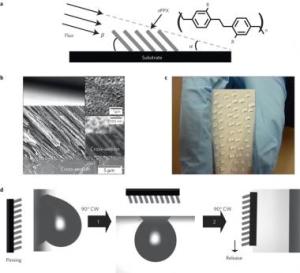Nov 24 2010
In nature, water striders can walk on water, butterflies can shed water from their wings, and plants can trap insects and pollen.
 a, Schematic of PPX nanofilm deposition by OAP. b, Electron microscope cross-section of PPX nanofilm (insets show top view and high-resolution cross-section micrographs). c, Picture of the anisotropic adhesive wetting surface with water drops. d, Water adhesion and release in three configurations of the nanofilm. Schematics illustrate the nanorod inclination at each tilt angle and correspond to photographs showing the anisotropic wetting behaviour of the nanofilm.
a, Schematic of PPX nanofilm deposition by OAP. b, Electron microscope cross-section of PPX nanofilm (insets show top view and high-resolution cross-section micrographs). c, Picture of the anisotropic adhesive wetting surface with water drops. d, Water adhesion and release in three configurations of the nanofilm. Schematics illustrate the nanorod inclination at each tilt angle and correspond to photographs showing the anisotropic wetting behaviour of the nanofilm.
Scientists at the Naval Research Laboratory are part of a research team working to engineer surfaces that imitate some of these water repellency features found in nature.
This technology offers the possibility of significant advances for producing new generations of coatings that will be of great value for military, medical, and energy applications. The research is published in the December 2010 issue of Nature Materials.
Dr. Walter Dressick from NRL, working with Professor Melik Demirel of Penn State and Dr. Matthew Hancock of MIT, have collaborated to create an engineered water-repellant thin film. What sets this development apart from earlier technologies is that this newest film has the ability to control the directionality of liquid transport.
In this system, parylene nanorods are deposited on the surface by a simple, straightforward vapor deposition method. The single step usually takes less than 60 minutes, compared with the more complex, multi-step lithography processes often used in previous systems. This is the first time this kind of surface has been engineered at the nanoscale.
In the newly created surface, the nanorods that form the film are smooth on a micron scale. This size and smoothness in the posts means that when droplets are placed on the surface, they move without being distorted in any way. Also, they can be moved without pumps or optical waves. Previous systems caused the water droplets to be distorted, which could rupture, spill, or destroy the cargo in the droplet when used in medical or microassembly applications. As they continue the research, the team will focus on optimizing the droplet transport mechanism and tuning the preparation method.
Looking to the future, researchers are hopeful that this film could be used as a coating on the hull of ships where it would reduce the drag and slow the fouling. In industry applications, the film might have uses in directional syringes and fluid diodes, pump-free digital fluidic devices, increased efficiency of thermal cooling for microchips, and tire coatings.